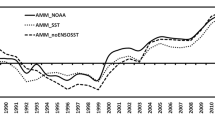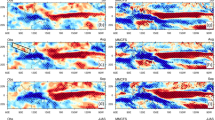Abstract
Indian summer monsoon rainfall (ISMR) provides 80% of India’s total annual precipitation and thus has a tremendous impact on water resource management, agricultural yield and,consequently, India’s gross domestic product. Because of its importance, different studies have examined climatic controls on ISMR. Here we found a link between the spring (March–May; MAM) Atlantic meridional mode (AMM) and the ISMR, with the strengthening (weakening) of ISMR during the positive (negative) phase of the AMM. During the positive phase of the spring AMM, warmer sea surface temperatures (SSTs) persist over the tropical north Atlantic Ocean, strengthening anomalous cyclonic circulation and strengthening convection over the Sahel region; this process, in turn, modulates the winds over the Western Indian Ocean, cooling SST and strengthening monsoon circulation over India. However, during the negative phase of the spring AMM, we notice a weakening of the monsoon circulation over India. As a way of highlighting the importance of this climate connection, we compare the skill in forecasting ISMR using the information from the pre-monsoon AMM against the forecasts from the North American Multi-Model Ensemble (NMME). Over the years 1981–2017, our simple model produces more accurate results than the NMME models, and further highlights the crucial role played by pre-monsoon AMM in modulating the IMSR. This new finding will allow for Indian farmers and policy makers to better anticipate water availability from ISMR.







Similar content being viewed by others
References
Amaya DJ, DeFlorio MJ, Miller AJ, Xie SP (2017) WES feedback and the Atlantic Meridional Mode: observations and CMIP5 comparisons. Clim Dyn 49(5–6):1665–1679
Annamalai H, Potemra J, Murtugudde R, McCreary JP (2005) Effect of preconditioning on the extreme climate events in the tropical Indian Ocean. J Clim 18(17):3450–3469
Brierley C, Wainer I (2018) Inter-annual variability in the tropical Atlantic from the Last Glacial Maximum into future climate projections simulated by CMIP5/PMIP3. Clim Past 14(10):1377–1390
Burls NJ, Reason CC, Penven P, Philander SG (2012) Energetics of the tropical Atlantic zonal mode. J Clim 25(21):7442–7466
Chakraborty A (2018) Preceding winter La Niña reduces Indian summer monsoon rainfall. Environ Res Lett 13(5):054030
Chakraborty A, Agrawal S (2017) Role of west Asian surface pressure in summer monsoon onset over central India. Environ Res Lett 12(7):074002
Chang P, Ji L, Li H (1997) A decadal climate variation in the tropical Atlantic Ocean from thermodynamic air-sea interactions. Nature 385(6616):516
Charney JG, Shukla J (1981) Predictability of monsoons. In: Lighthill J, Pearce RP (eds) Monsoon dynamics. Cambridge University Press, Cambridge, pp 99–108
Chiang JCH, Vimont DJ (2004) Analogous meridional modes of atmosphere–ocean variability in the tropical Pacific and tropical Atlantic. J Clim 17(21):4143–4158
Gadgil S, Vinayachandran PN, Francis PA, Gadgil S (2004) Extremes of the Indian summer monsoon rainfall, ENSO and equatorial Indian Ocean oscillation. Geophys Res Lett 31:L12213
Ghosh S, Vittal H, Sharma T, Karmakar S, Kasiviswanathan KS, Dhanesh Y, Sudheer KP, Gunthe SS (2016) Indian summer monsoon rainfall: implications of contrasting trends in the spatial variability of means and extremes. PLoS ONE 11(7):e0158670
Goswami BN, Xavier PK (2005) Dynamics of “internal” interannual variability of the Indian summer monsoon in a GCM. J Geophys Res Atmos 110(D24).
Goswami BN, Madhusoodanan MS, Neema CP, Sengupta D (2006a) A physical mechanism for North Atlantic SST influence on the Indian summer monsoon. Geophys Res Lett 33(2):L02706. https://doi.org/10.1029/2005GL024803
Goswami BN, Venugopal V, Sengupta D, Madhusoodanan MS, Xavier PK (2006b) Increasing trend of extreme rain events over India in a warming environment. Science 314(5804):1442–1445
Kalnay E, Kanamitsu M, Kistler R, Collins W, Deaven D, Gandin L, Iredell M, Saha S, White G, Woollen J, Zhu Y (1996) The NCEP/NCAR 40-year reanalysis project. Bull Am Meteorol Soc 77(3):437–472
Kirtman BP, Min D, Infanti JM, Kinter JL III, Paolino DA, Zhang Q, Van Den Dool H, Saha S, Mendez MP, Becker E, Peng P (2014) The North American multimodel ensemble: phase-1 seasonal-to-interannual prediction; phase-2 toward developing intraseasonal prediction. Bull Am Meteorol Soc 95(4):585–601
Kucharski F, Bracco A, Yoo JH, Molteni F (1990s) Low-frequency variability of the Indian monsoon–ENSO relationship and the tropical Atlantic: the “weakening” of the 1980s and 1990s. J Clim 20(16):4255–4266
Kucharski F, Bracco A, Yoo JH, Molteni F (2008) Atlantic forced component of the Indian monsoon interannual variability. Geophys Res Lett 35(4):L04706
Kucharski F, Bracco A, Yoo JH, Tompkins AM, Feudale L, Ruti P, Dell'Aquila A (2009) A Gill–Matsuno-type mechanism explains the tropical Atlantic influence on African and Indian monsoon rainfall. Q J R Meteorol Soc 135(640):569–579
Kumar KK, Rajagopalan B, Cane MA (1999) On the weakening relationship between the Indian monsoon and ENSO. Science 284(5423):2156–2159
Lübbecke JF, Böning CW, Keenlyside NS, Xie SP (2010) On the connection between Benguela and equatorial Atlantic Niños and the role of the South Atlantic Anticyclone. J Geophys Res Oceans 115(C9):C09015. https://doi.org/10.1029/2009JC005964
Maity R, Kumar ND (2006) Hydroclimatic association of monthly summer monsoon rainfall over India with large-scale atmospheric circulation from tropical Pacific Ocean and Indian Ocean region. Atmos Sci Lett 7:101–107
Martin ER, Thorncroft C, Booth BB (2014) The multidecadal Atlantic SST—Sahel rainfall teleconnection in CMIP5 simulations. J Clim 27(2):784–806
Mitchell TD, Jones PD (2005) An improved method of constructing a database of monthly climate observations and associated high-resolution grids. Int J Climatol 25(6):693–712
Mooley DA, Parthasarathy B (1983) Indian summer monsoon and El Niño. Pageoph 121(2):339–352
Parthasarathy B, Rupa Kumar K, Deshpande VR (1991) Indian summer monsoon rainfall and 200 mb meridional wind index: application for long range prediction. Int J Climatol 11:165–176
Pottapinjara V, Girishkumar MS, Sivareddy S, Ravichandran M, Murtugudde R (2016) Relation between the upper ocean heat content in the equatorial Atlantic during boreal spring and the Indian monsoon rainfall during June–September. Int J Climatol 36(6):2469–2480
Rajeevan M, Pai DS, Dikshit SK, Kelkar RR (2004) IMD’s new operational models for long-range forecast of southwest monsoon rainfall over India and their verification for 2003. Curr Sci 86(3):422–431
Rajeevan M, Unnikrishnan CK, Preethi B (2012) Evaluation of the ENSEMBLES multi-model seasonal forecasts of Indian summer monsoon variability. Clim Dyn 38(11–12):2257–2274
Rasmusson EM, Carpenter TH (1983) The relationship between eastern equatorial Pacific sea surface temperatures and rainfall over India and Sri Lanka. Mon Weather Rev 111(3):517–528
Rayner NA, Parker DE, Horton EB, Folland CK, Alexander LV, Rowell DP, Kent EC, Kaplan A (2003) Global analyses of sea surface temperature, sea ice, and night marine air temperature since the late nineteenth century. J Geophy Res Atmos 108(D14):4407. https://doi.org/10.1029/2002JD002670
Rigby RA, Stasinopoulos DM (2005) Generalized additive models for location, scale and shape. J R Stat Soc Ser C (Appl Stat) 54(3):507–554
Roxy MK, Ritika K, Terray P, Murtugudde R, Ashok K, Goswami BN (2015) Drying of Indian subcontinent by rapid Indian Ocean warming and a weakening land-sea thermal gradient. Nat Commun 6:7423
Sabeerali CT, Rao SA, Dhakate AR, Salunke K, Goswami BN (2015) Why ensemble mean projection of south Asian monsoon rainfall by CMIP5 models is not reliable? Clim Dyn 45(1–2):161–174
Sabeerali CT, Ajayamohan RS, Rao SA (2019) Loss of predictive skill of Indian summer monsoon rainfall in NCEP CFSv2 due to misrepresentation of Atlantic zonal mode. Clim Dyn 52(7–8):4599–4619
Saha A, Ghosh S, Sahana AS, Rao EP (2014) Failure of CMIP5 climate models in simulating post-1950 decreasing trend of Indian monsoon. Geophys Res Lett 41(20):7323–7330
Saha SK, Hazra A, Pokhrel S, Chaudhari HS, Sujith K, Rai A, Rahaman H, Goswami BN (2019) Unraveling the mystery of Indian summer monsoon prediction: improved estimate of predictability limit. J Geophys Res Atmos 124(4):1962–1974
Sahastrabuddhe R, Ghosh S, Saha A, Murtugudde R (2019) A minimalistic seasonal prediction model for Indian monsoon based on spatial patterns of rainfall anomalies. Clim Dyn 52(5–6):3661–3681
Saji NH, Goswami BN, Vinayachandran PN, Yamagata T (1999) A dipole mode in the tropical Indian Ocean. Nature 401:360–363
Vathsala H, Koolagudi SG (2016) Long-Range prediction of Indian summer monsoon rainfall using data mining and statistical approaches. Theor Appl Climatol 130:19–33
Walker GT (1993) Seasonal weather and its prediction. Nature 132:805–808
Wang B, Xiang B, Li J, Webster PJ, Rajeevan MN, Liu J, Ha KJ (2015) Rethinking Indian monsoon rainfall prediction in the context of recent global warming. Nature Commun 6:7154
Wu R, Kirtman BP (2004) Impacts of the Indian Ocean on the summer monsoon-ENSO relationship. J Clim 17:3037–3054
Yamagata T, Behera SK, Luo J, Masson S, Jury MR, Rao AS (2004) Coupled ocean–atmosphere variability in the tropical Indian Ocean. Earth’s Climate: the Ocean-Atmosphere Interaction. Geophys Monogr 147:189–212
Acknowledgements
Vittal H. acknowledges the support by Fulbright-Kalam Fellowship (Grant 2338/FKPDR/2018). This study was also supported by the National Science Foundation under CAREER Grant AGS-1349827 and the USACE Institute for Water Resources. (G.V.). We gratefully acknowledge Rhawn Denniston's comment and suggestions. The authors also thank the Editor and two anonymous reviewers whose valuable suggestions improved the quality and readability of the manuscript.
Author information
Authors and Affiliations
Corresponding author
Additional information
Publisher's Note
Springer Nature remains neutral with regard to jurisdictional claims in published maps and institutional affiliations.
Electronic supplementary material
Below is the link to the electronic supplementary material.
Rights and permissions
About this article
Cite this article
Vittal, H., Villarini, G. & Zhang, W. Early prediction of the Indian summer monsoon rainfall by the Atlantic Meridional Mode. Clim Dyn 54, 2337–2346 (2020). https://doi.org/10.1007/s00382-019-05117-0
Received:
Accepted:
Published:
Issue Date:
DOI: https://doi.org/10.1007/s00382-019-05117-0




